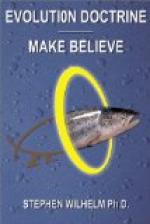* * * * *
Let us now turn back to some of the earlier pages of the embryological record which we passed over in order that we might translate the later portions dealing with more familiar and intelligible structures like gills. Before the egg of the frog becomes an elliptical mass of cells, it is at one time a double-walled sac enclosing a central cavity; in this stage it is called a gastrula. Tracing back the mode of its formation, we find that it is produced from a hollow sphere of fewer cells that are essentially alike; this stage also is so important that the special term blastula is applied to it. Still earlier, there are fewer cells—128 or thereabouts, 64, 32, 16, 8, 4, 2, and 1. In other words, the starting point in the development of the frog is a single biological unit; this divides and its products redivide to constitute the many-celled blastula and the double-walled gastrula. All the other animals we have mentioned begin like the frog, as eggs which are single cells and nothing more; they too pass on to become blastulae and gastrulae, similar to those of the frog in all essential respects, particularly as regards the nature of the organs produced by each of the two primary layers, and the mode of their formation. Does the occurrence of blastulae and gastrulae and one-celled beginnings mean that the higher animals composed of numerous and much differentiated cells have evolved in company from two-layered saccular ancestors which were themselves the descendants of spherical colonies of like cells, and ultimately of one-celled animals?
Comparative anatomy has asserted that this is so, as we have already learned, for it finds that adult animals array themselves at different levels of a scale beginning at the bottom with the protozoa, continuing on to the two-layered animals like Hydra and jellyfish and sea-anemones, and then extending upwards to the region of the more complicated invertebrates and vertebrates. It was difficult perhaps to believe that these successive grades of organic structure indicated an order of evolution, because it seemed impossible that an animal so simple as a protozoan could produce offspring with the complex organization of a frog or a cat, even in long ages. But development delivers its evidence relating to this matter with telling and impressive force. How can we doubt the possibility of an evolution of higher animals from ancestors as simple as Hydra and Amoeba when a frog and a cat, like all other complicated organisms, begin individual existence as single cells, and pass through gastrula stages? If we deny it, we contradict the evidence of our senses, for the development is actually accomplished by the transformation of a single cell into a double-walled sac, and of this into different and more intricate organic mechanisms. The process can take place, for it does take place. Not until the investigator becomes




